Emergency Nursing Essay: Overcrowding and Nurse Shortage Solutions
VerifiedAdded on 2022/08/14
|6
|1079
|323
Essay
AI Summary
This essay addresses the critical issue of nurse shortages in emergency departments, specifically focusing on the impact of a 1:4 nurse-to-patient ratio in overcrowded settings. It explores the consequences of this shortage, including increased workload, medication errors, and potential impacts on patient morbidity and mortality. The essay proposes a solution-focused approach, advocating for increased government funding to recruit more qualified emergency nurses and reduce the patient ratio. It references Australian examples and policies, such as the NSW Department of Health initiatives, to support the argument. The essay also highlights the importance of providing professional development opportunities for nurses and emphasizes the potential benefits of adequate staffing levels in terms of improved patient satisfaction and overall care quality. The conclusion reinforces the need for skilled nursing professionals and flexible working conditions to alleviate the challenges associated with nursing shortages.
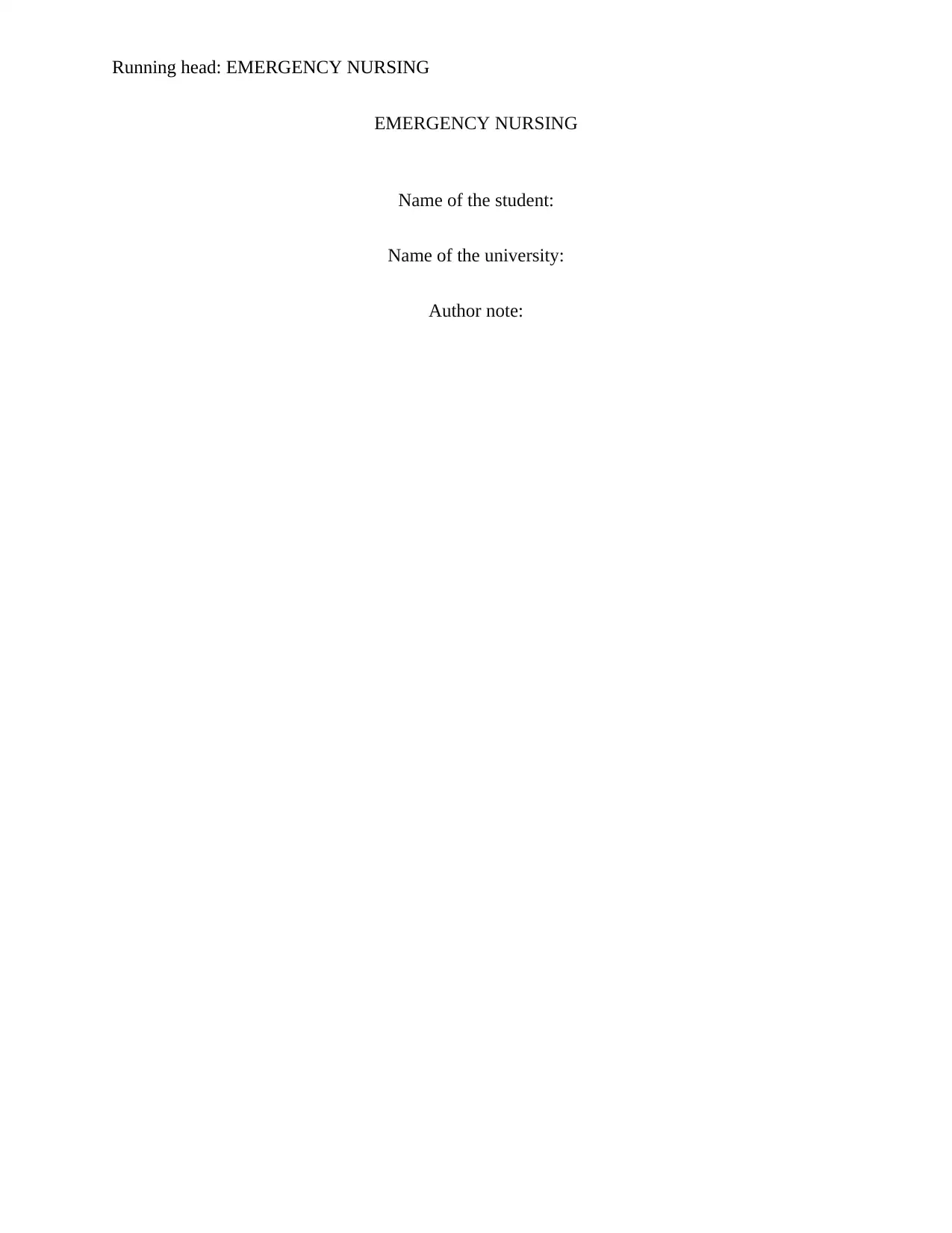
Running head: EMERGENCY NURSING
EMERGENCY NURSING
Name of the student:
Name of the university:
Author note:
EMERGENCY NURSING
Name of the student:
Name of the university:
Author note:
Paraphrase This Document
Need a fresh take? Get an instant paraphrase of this document with our AI Paraphraser
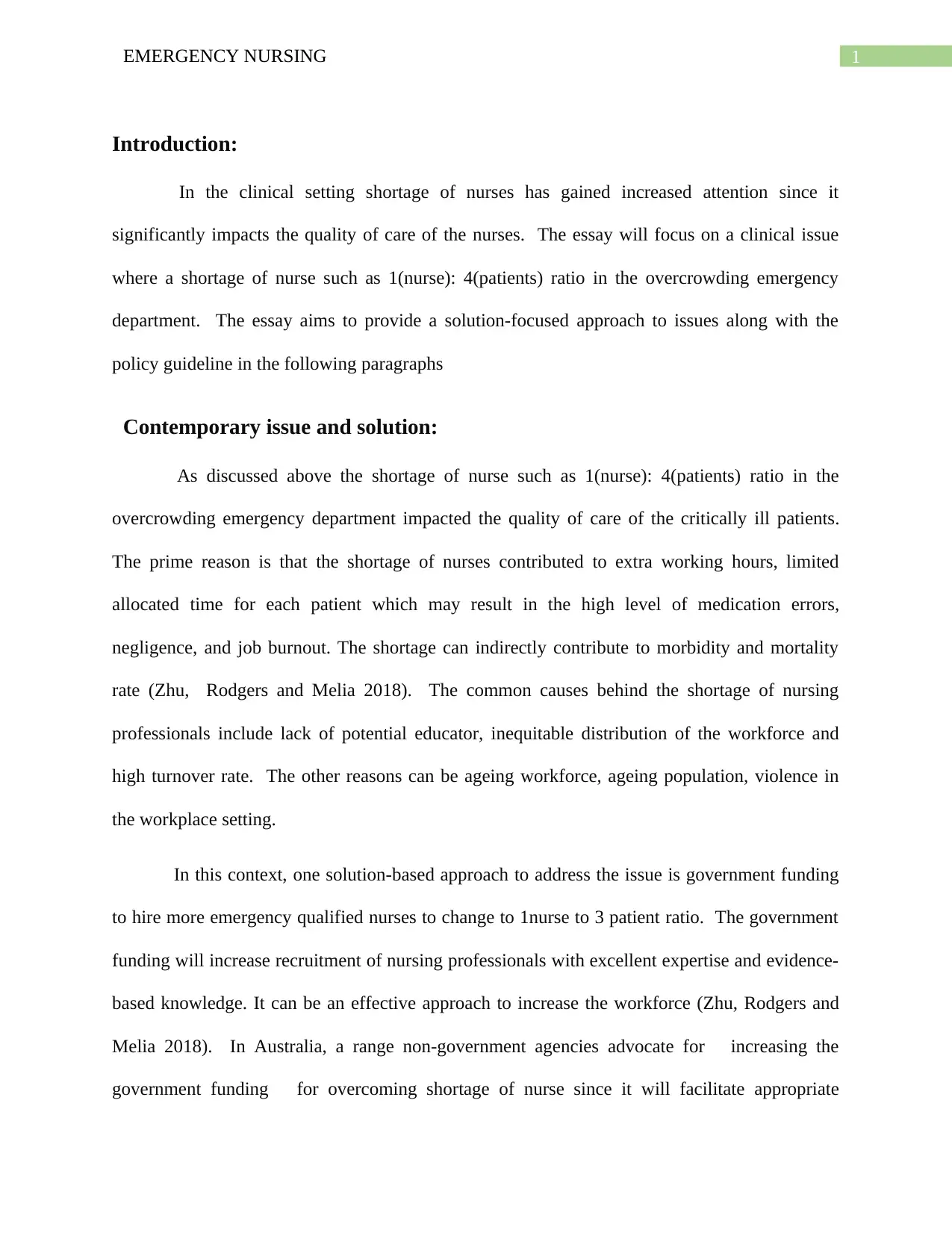
1EMERGENCY NURSING
Introduction:
In the clinical setting shortage of nurses has gained increased attention since it
significantly impacts the quality of care of the nurses. The essay will focus on a clinical issue
where a shortage of nurse such as 1(nurse): 4(patients) ratio in the overcrowding emergency
department. The essay aims to provide a solution-focused approach to issues along with the
policy guideline in the following paragraphs
Contemporary issue and solution:
As discussed above the shortage of nurse such as 1(nurse): 4(patients) ratio in the
overcrowding emergency department impacted the quality of care of the critically ill patients.
The prime reason is that the shortage of nurses contributed to extra working hours, limited
allocated time for each patient which may result in the high level of medication errors,
negligence, and job burnout. The shortage can indirectly contribute to morbidity and mortality
rate (Zhu, Rodgers and Melia 2018). The common causes behind the shortage of nursing
professionals include lack of potential educator, inequitable distribution of the workforce and
high turnover rate. The other reasons can be ageing workforce, ageing population, violence in
the workplace setting.
In this context, one solution-based approach to address the issue is government funding
to hire more emergency qualified nurses to change to 1nurse to 3 patient ratio. The government
funding will increase recruitment of nursing professionals with excellent expertise and evidence-
based knowledge. It can be an effective approach to increase the workforce (Zhu, Rodgers and
Melia 2018). In Australia, a range non-government agencies advocate for increasing the
government funding for overcoming shortage of nurse since it will facilitate appropriate
Introduction:
In the clinical setting shortage of nurses has gained increased attention since it
significantly impacts the quality of care of the nurses. The essay will focus on a clinical issue
where a shortage of nurse such as 1(nurse): 4(patients) ratio in the overcrowding emergency
department. The essay aims to provide a solution-focused approach to issues along with the
policy guideline in the following paragraphs
Contemporary issue and solution:
As discussed above the shortage of nurse such as 1(nurse): 4(patients) ratio in the
overcrowding emergency department impacted the quality of care of the critically ill patients.
The prime reason is that the shortage of nurses contributed to extra working hours, limited
allocated time for each patient which may result in the high level of medication errors,
negligence, and job burnout. The shortage can indirectly contribute to morbidity and mortality
rate (Zhu, Rodgers and Melia 2018). The common causes behind the shortage of nursing
professionals include lack of potential educator, inequitable distribution of the workforce and
high turnover rate. The other reasons can be ageing workforce, ageing population, violence in
the workplace setting.
In this context, one solution-based approach to address the issue is government funding
to hire more emergency qualified nurses to change to 1nurse to 3 patient ratio. The government
funding will increase recruitment of nursing professionals with excellent expertise and evidence-
based knowledge. It can be an effective approach to increase the workforce (Zhu, Rodgers and
Melia 2018). In Australia, a range non-government agencies advocate for increasing the
government funding for overcoming shortage of nurse since it will facilitate appropriate
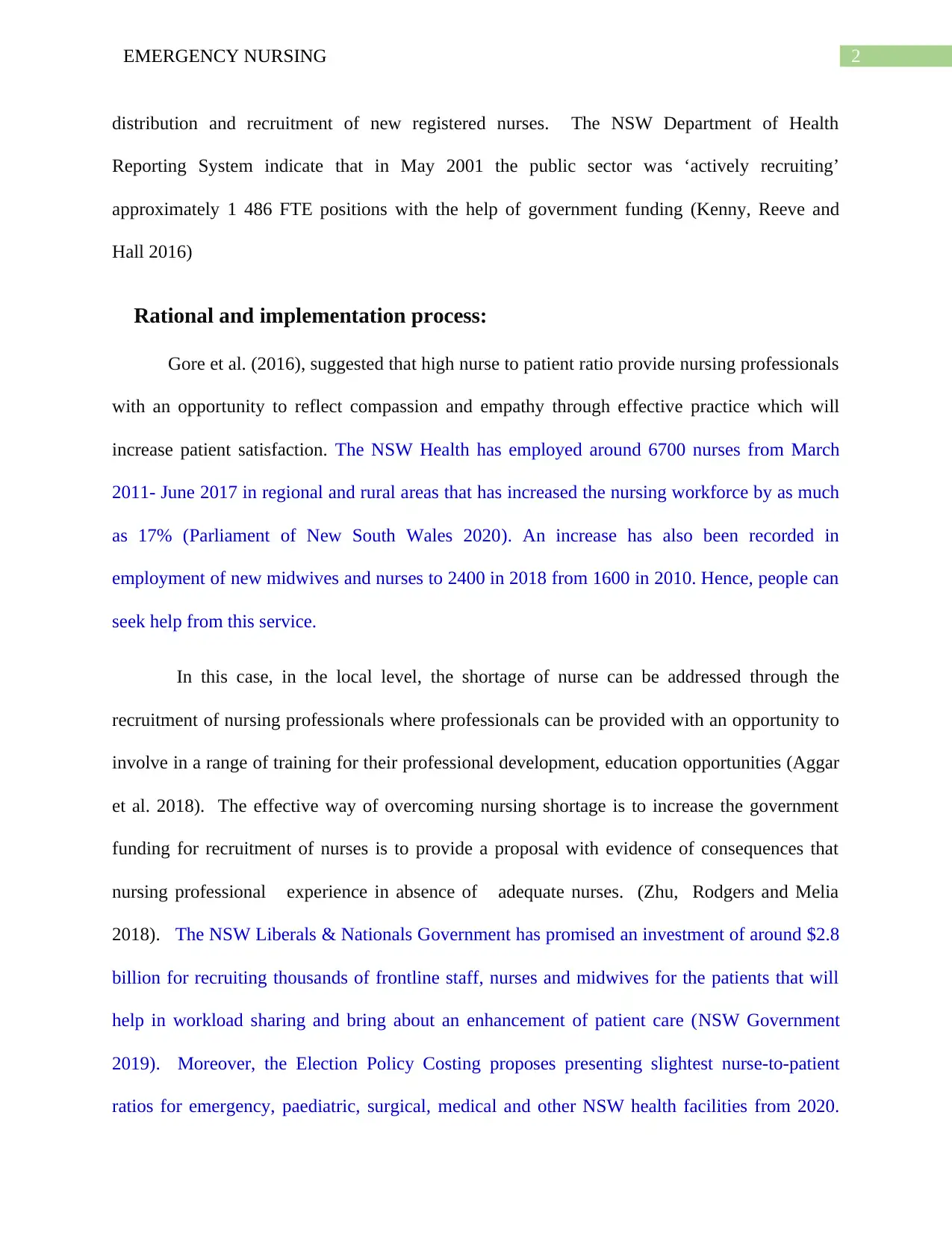
2EMERGENCY NURSING
distribution and recruitment of new registered nurses. The NSW Department of Health
Reporting System indicate that in May 2001 the public sector was ‘actively recruiting’
approximately 1 486 FTE positions with the help of government funding (Kenny, Reeve and
Hall 2016)
Rational and implementation process:
Gore et al. (2016), suggested that high nurse to patient ratio provide nursing professionals
with an opportunity to reflect compassion and empathy through effective practice which will
increase patient satisfaction. The NSW Health has employed around 6700 nurses from March
2011- June 2017 in regional and rural areas that has increased the nursing workforce by as much
as 17% (Parliament of New South Wales 2020). An increase has also been recorded in
employment of new midwives and nurses to 2400 in 2018 from 1600 in 2010. Hence, people can
seek help from this service.
In this case, in the local level, the shortage of nurse can be addressed through the
recruitment of nursing professionals where professionals can be provided with an opportunity to
involve in a range of training for their professional development, education opportunities (Aggar
et al. 2018). The effective way of overcoming nursing shortage is to increase the government
funding for recruitment of nurses is to provide a proposal with evidence of consequences that
nursing professional experience in absence of adequate nurses. (Zhu, Rodgers and Melia
2018). The NSW Liberals & Nationals Government has promised an investment of around $2.8
billion for recruiting thousands of frontline staff, nurses and midwives for the patients that will
help in workload sharing and bring about an enhancement of patient care (NSW Government
2019). Moreover, the Election Policy Costing proposes presenting slightest nurse-to-patient
ratios for emergency, paediatric, surgical, medical and other NSW health facilities from 2020.
distribution and recruitment of new registered nurses. The NSW Department of Health
Reporting System indicate that in May 2001 the public sector was ‘actively recruiting’
approximately 1 486 FTE positions with the help of government funding (Kenny, Reeve and
Hall 2016)
Rational and implementation process:
Gore et al. (2016), suggested that high nurse to patient ratio provide nursing professionals
with an opportunity to reflect compassion and empathy through effective practice which will
increase patient satisfaction. The NSW Health has employed around 6700 nurses from March
2011- June 2017 in regional and rural areas that has increased the nursing workforce by as much
as 17% (Parliament of New South Wales 2020). An increase has also been recorded in
employment of new midwives and nurses to 2400 in 2018 from 1600 in 2010. Hence, people can
seek help from this service.
In this case, in the local level, the shortage of nurse can be addressed through the
recruitment of nursing professionals where professionals can be provided with an opportunity to
involve in a range of training for their professional development, education opportunities (Aggar
et al. 2018). The effective way of overcoming nursing shortage is to increase the government
funding for recruitment of nurses is to provide a proposal with evidence of consequences that
nursing professional experience in absence of adequate nurses. (Zhu, Rodgers and Melia
2018). The NSW Liberals & Nationals Government has promised an investment of around $2.8
billion for recruiting thousands of frontline staff, nurses and midwives for the patients that will
help in workload sharing and bring about an enhancement of patient care (NSW Government
2019). Moreover, the Election Policy Costing proposes presenting slightest nurse-to-patient
ratios for emergency, paediatric, surgical, medical and other NSW health facilities from 2020.
⊘ This is a preview!⊘
Do you want full access?
Subscribe today to unlock all pages.

Trusted by 1+ million students worldwide
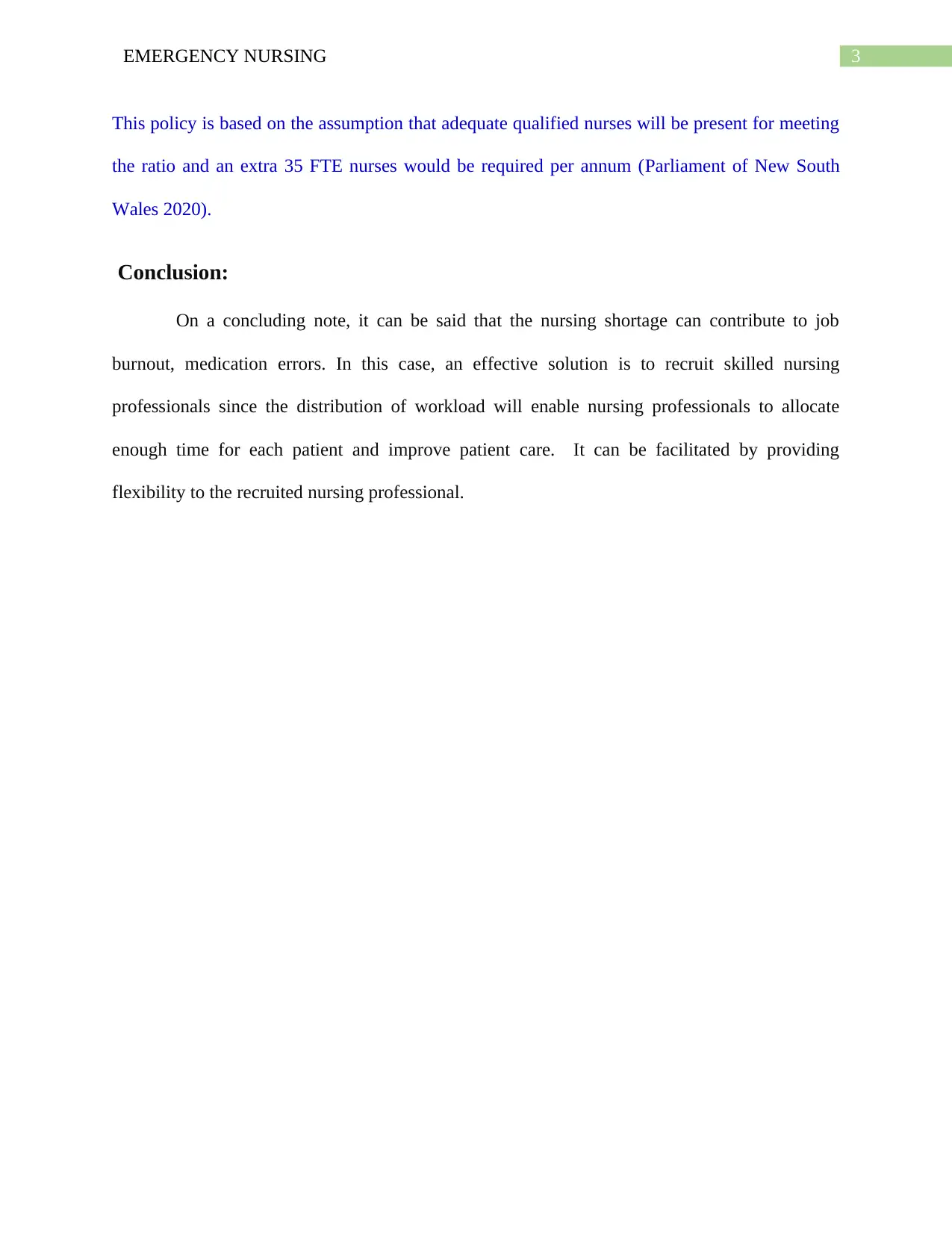
3EMERGENCY NURSING
This policy is based on the assumption that adequate qualified nurses will be present for meeting
the ratio and an extra 35 FTE nurses would be required per annum (Parliament of New South
Wales 2020).
Conclusion:
On a concluding note, it can be said that the nursing shortage can contribute to job
burnout, medication errors. In this case, an effective solution is to recruit skilled nursing
professionals since the distribution of workload will enable nursing professionals to allocate
enough time for each patient and improve patient care. It can be facilitated by providing
flexibility to the recruited nursing professional.
This policy is based on the assumption that adequate qualified nurses will be present for meeting
the ratio and an extra 35 FTE nurses would be required per annum (Parliament of New South
Wales 2020).
Conclusion:
On a concluding note, it can be said that the nursing shortage can contribute to job
burnout, medication errors. In this case, an effective solution is to recruit skilled nursing
professionals since the distribution of workload will enable nursing professionals to allocate
enough time for each patient and improve patient care. It can be facilitated by providing
flexibility to the recruited nursing professional.
Paraphrase This Document
Need a fresh take? Get an instant paraphrase of this document with our AI Paraphraser
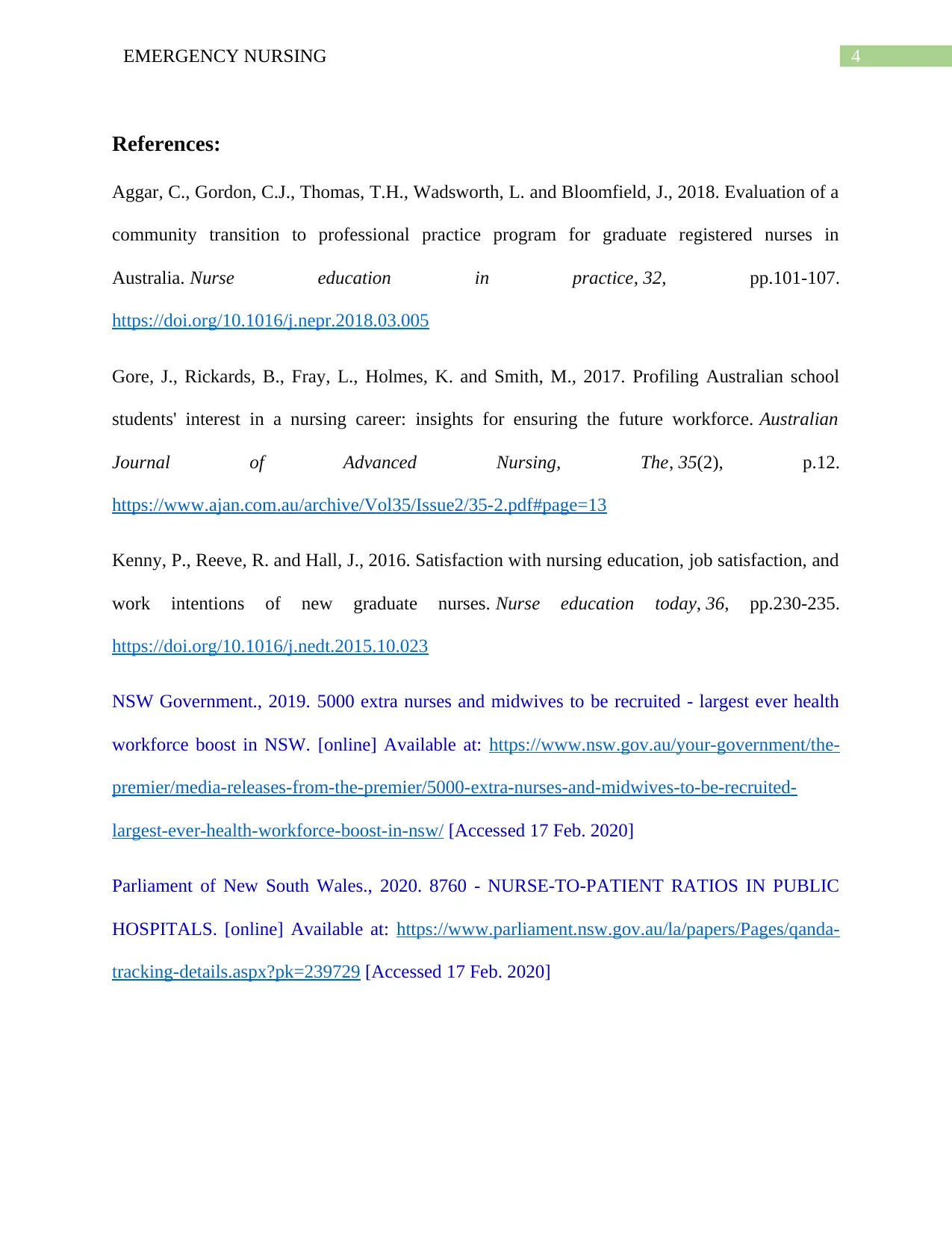
4EMERGENCY NURSING
References:
Aggar, C., Gordon, C.J., Thomas, T.H., Wadsworth, L. and Bloomfield, J., 2018. Evaluation of a
community transition to professional practice program for graduate registered nurses in
Australia. Nurse education in practice, 32, pp.101-107.
https://doi.org/10.1016/j.nepr.2018.03.005
Gore, J., Rickards, B., Fray, L., Holmes, K. and Smith, M., 2017. Profiling Australian school
students' interest in a nursing career: insights for ensuring the future workforce. Australian
Journal of Advanced Nursing, The, 35(2), p.12.
https://www.ajan.com.au/archive/Vol35/Issue2/35-2.pdf#page=13
Kenny, P., Reeve, R. and Hall, J., 2016. Satisfaction with nursing education, job satisfaction, and
work intentions of new graduate nurses. Nurse education today, 36, pp.230-235.
https://doi.org/10.1016/j.nedt.2015.10.023
NSW Government., 2019. 5000 extra nurses and midwives to be recruited - largest ever health
workforce boost in NSW. [online] Available at: https://www.nsw.gov.au/your-government/the-
premier/media-releases-from-the-premier/5000-extra-nurses-and-midwives-to-be-recruited-
largest-ever-health-workforce-boost-in-nsw/ [Accessed 17 Feb. 2020]
Parliament of New South Wales., 2020. 8760 - NURSE-TO-PATIENT RATIOS IN PUBLIC
HOSPITALS. [online] Available at: https://www.parliament.nsw.gov.au/la/papers/Pages/qanda-
tracking-details.aspx?pk=239729 [Accessed 17 Feb. 2020]
References:
Aggar, C., Gordon, C.J., Thomas, T.H., Wadsworth, L. and Bloomfield, J., 2018. Evaluation of a
community transition to professional practice program for graduate registered nurses in
Australia. Nurse education in practice, 32, pp.101-107.
https://doi.org/10.1016/j.nepr.2018.03.005
Gore, J., Rickards, B., Fray, L., Holmes, K. and Smith, M., 2017. Profiling Australian school
students' interest in a nursing career: insights for ensuring the future workforce. Australian
Journal of Advanced Nursing, The, 35(2), p.12.
https://www.ajan.com.au/archive/Vol35/Issue2/35-2.pdf#page=13
Kenny, P., Reeve, R. and Hall, J., 2016. Satisfaction with nursing education, job satisfaction, and
work intentions of new graduate nurses. Nurse education today, 36, pp.230-235.
https://doi.org/10.1016/j.nedt.2015.10.023
NSW Government., 2019. 5000 extra nurses and midwives to be recruited - largest ever health
workforce boost in NSW. [online] Available at: https://www.nsw.gov.au/your-government/the-
premier/media-releases-from-the-premier/5000-extra-nurses-and-midwives-to-be-recruited-
largest-ever-health-workforce-boost-in-nsw/ [Accessed 17 Feb. 2020]
Parliament of New South Wales., 2020. 8760 - NURSE-TO-PATIENT RATIOS IN PUBLIC
HOSPITALS. [online] Available at: https://www.parliament.nsw.gov.au/la/papers/Pages/qanda-
tracking-details.aspx?pk=239729 [Accessed 17 Feb. 2020]

5EMERGENCY NURSING
Parliament of New South Wales., 2020. Parliamentary Budget Office - Election Policy Costing.
[online] Available at: https://www.parliament.nsw.gov.au/pbo/Documents/2019%20ALP
%20Election%20Policy%20Costings/B322%20-%20Costing.pdf [Accessed 17 Feb. 2020]
Zhu, J., Rodgers, S. and Melia, K.M., 2018. Understanding Human Resource Wastage in the
Nursing Shortage: Lessons Learned from Chinese Nurses Leaving Nursing Practice. Athens
Journal of Health, 5(3), pp.195-211. https://www.athensjournals.gr/health/2018-5-3-2-Zhu.pdf
Parliament of New South Wales., 2020. Parliamentary Budget Office - Election Policy Costing.
[online] Available at: https://www.parliament.nsw.gov.au/pbo/Documents/2019%20ALP
%20Election%20Policy%20Costings/B322%20-%20Costing.pdf [Accessed 17 Feb. 2020]
Zhu, J., Rodgers, S. and Melia, K.M., 2018. Understanding Human Resource Wastage in the
Nursing Shortage: Lessons Learned from Chinese Nurses Leaving Nursing Practice. Athens
Journal of Health, 5(3), pp.195-211. https://www.athensjournals.gr/health/2018-5-3-2-Zhu.pdf
⊘ This is a preview!⊘
Do you want full access?
Subscribe today to unlock all pages.

Trusted by 1+ million students worldwide
1 out of 6
Related Documents
Your All-in-One AI-Powered Toolkit for Academic Success.
+13062052269
info@desklib.com
Available 24*7 on WhatsApp / Email
![[object Object]](/_next/static/media/star-bottom.7253800d.svg)
Unlock your academic potential
Copyright © 2020–2025 A2Z Services. All Rights Reserved. Developed and managed by ZUCOL.




